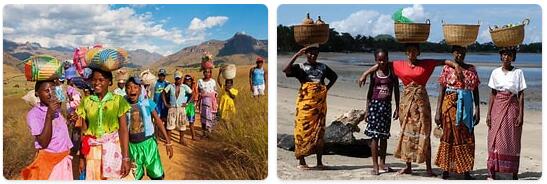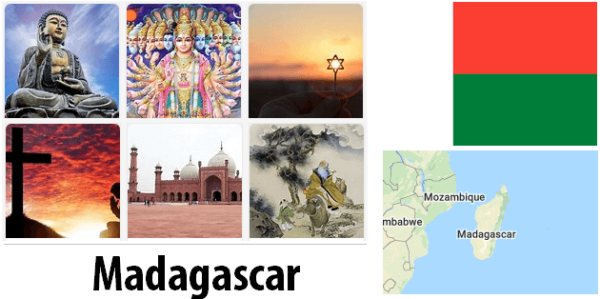Population
In 2019 Madagascar had an average population density of 45 residents per km2. However, due to topographical and ecological conditions, the population is unevenly distributed, and the density varies from just over 130 residents per km2 in the central highlands area to only 2 residents per km2 along the west coast.
37 percent of the population lived in cities, of which the capital Antananarivo (1.3 million residents, 2015) was the largest.
The people of Madagascar, the Malagasy, have a common language and, to a large extent, a common culture and view of life. Officially there is a division into 18 people groups with different dialects and geographical areas. Migrations and conquests, as well as external influences, earlier from Arab seafarers, later from European missionaries and colonizers, have influenced and, in some cases, created certain groups. The origin of the Madagascar is partly unknown. Their language, Malagasy, belongs to the Austronesian languages, and this, as well as the technique of irrigating and terracing rice crops, indicates an immigration from Indonesia, possibly via the east coast of Africa (where the Zebu can be and the emotional relation to the cattle).
The traditional view of life is dominated by the reverence for the ancestors. The Christian faith has quite well been incorporated into the belief in the ancestral wisdom and ability to bless the living. An astrological calendar system with days and months of travel in relation to different weather patterns is an influence from Islam, spread throughout the island.
The Indonesian heritage is most evident on the high plateau, where the largest population group of merina (5 million) lives. Divorce has meant that the marina retains a distinct Southeast Asian appearance. Each lineage group inherits rice crops and access to the ancestral tomb. Although you no longer live on the ancestral land, many families return there for joint ceremonies, especially during the reburial of the dead, as the family ties are strengthened and the ancestors blessed.
Betsileo (2.4 million), south of the merina, is also counted among the peoples of the high plateau, and their livelihood systems and culture are similar in many merinas. On the east coast, rice, coffee and vanilla are grown, and in the rain forest belt there is burning, hunting and gathering. The west coast is dominated by a wide lowland belt, with some rice cultivation, large livestock herds and fishing.
Betsimisaraka (3 million) on the east coast and sakalava(1.3 million) on the west coast have both had state formations with the kingdom and incorporated other smaller groups into their territories. In southern Madagascar, many smaller groups of people live, fishermen around the coasts and along the rivers, semi-nomadic livestock keepers inland. Antaimoro (873,000) in the southeast is famous for its sacred writings, written in Malagasy with Arabic characters. In the tropical forests in the southwestern part of the country there is a group of hunters and collectors called mikea (1,500). Part of the year they catch and collect small mammals (lemurs, stray cats, tanrecs) and other jungles (bird, fish, honey, starchy tubers, nuts, fruits), at other times they devote themselves to cultivation.
Within several of the ethnic groups there is a kind of caste system, where the biggest difference is between descendants of slaves (andevo), and descendants of free men (hova) and princesses (andriana)). Today this is less important, rather the difference between city and countryside, educated and uneducated is the clearest. Another division, which is sometimes actualized, is that between the people on the high plateau (merina and betsileo) and the coastal population, to which all the rest are counted. This distinction has its roots in the dominance of the merina during the 19th century and has been renewed in the ongoing political democratization process. Since the end of the 19th century, Indians (25,000) have settled in Madagascar. In recent years, a rather large Chinese immigrant group (51,000) has been established on the island.

Language
The completely dominant language is Malagasy. However, the dialectal variation in this language is large. Malagasy is the official language along with French. See also population above.
Religion
The Catholic Church was established in Madagascar in the 16th century by Christian missionaries who had come with Portuguese merchants. In 2010, the Catholic Church comprised about a quarter of the population. During the first part of the 19th century, European influence and Protestant English missionaries, invited by King Radama I, established schools.
At his death in 1828, King Radama I was succeeded by his widow, Ranavalona I, who, unlike his deceased husband, was strongly negative to the Europeanization of Madagascar. She expelled European missionaries and merchants, and persecuted those who had converted to Christianity. When Ranavalona died in 1861, Madagascar was suspended for European influence. However, Europeans returned when Ranavaluna’s son Radama IIbecame king. English Protestants and French Catholics sought supremacy and European businessmen appealed to large concessions. However, Radama was assassinated in 1863. His wife Rasoherina became queen, but the real power came to be with Prime Minister Rainilaiarivony who married the queen. Rainilaiarivony (who also married the following queens Ranavalona II and Ranavalona III) embarked on a modernization program which reinstated Protestantism, suppressed traditional religion and established compulsory teaching under the leadership of the Christian missions. Over time, French influence increased and in 1896–1960 the country was a French colony.
Today (2010), about a third of the population is Protestant. The largest Protestant community is Madagascar Lutheran Church, founded in 1866, which is about one-sixth of the population. Another Protestant organization, with member churches of various Christian traditions, is the Church of Madagascar Jesus Christ (Fiangonan’i Jesoa Kristy eto Madagasikara, FJKM) which started its activity in the country in 1818. This is seen by some as the National Church of Madagascar, but it is not a state church and comprises just over a tenth of the population.
Many Madagascans, about two-fifths, profess indigenous religions, in which the deceased’s spirits and ancestral cult play a particularly prominent role. Islam, which covers almost a tenth of the population, is concentrated in the northern and northwestern parts of the country and most Muslims are of Indian or Pakistani origin. There are also small groups of Hindus, Jehovah’s Witnesses, Mormons, Seventh-day Adventists, and Jews.
In the preamble to the 2010 Constitution, the sovereign Malagasy people “affirm their belief in God as Creator”. Incidentally, according to the constitution, the country is a secular democratic republic which guarantees freedom of religion. Broadly speaking, religious freedom seems to prevail, but there is some persecution of politically active Christians. Also, Islamic communities do not have the same benefits as other religious communities, as they often do not meet the set requirements of legitimate religious communities because they require citizenship, which a large proportion of the Muslim population lacks.
According to thesciencetutor, the four largest Christian faith communities are part of the Madagascar Christian Council (Fiombonan’ny Fiangonana Kristianina eto Madagasikara, FFKM). These played a major role in public life until the coup d’état in March 2009. The Catholic Archbishop acted as mediator between the government and the opposition, but after the coup FFKM has withdrawn from politics, mainly because of internal divisions where the FJKM openly criticizes the regime while the leaders of the Catholic Church (associated with the current regime) distance themselves from political struggle.
